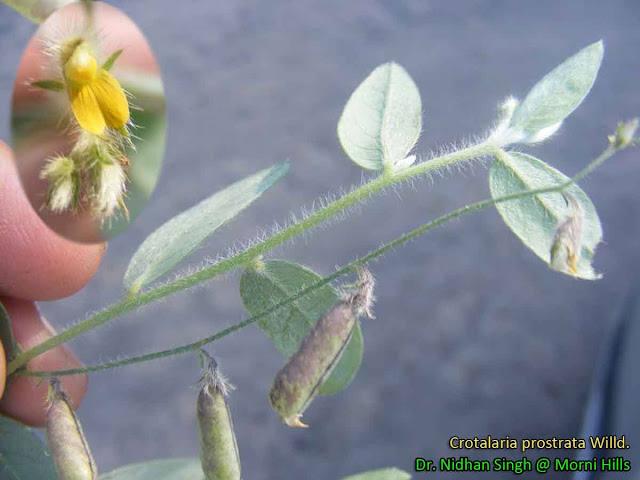 Crotalaria prostrata Willd.
Crotalaria prostrata Willd.Family: Fabaceae
Synonyms: Crotalaria prostrata D.Don, Crotalaria prostrata Roxb. , Crotalaria prostrata var. prostrata
- Chinese: 俯伏猪屎豆 fu fu zhu shi dou
- Kannada: balli gejje gida
- Hindi: bandar lathi, choto jhanjhan, choto jhunghyn
- Nepalese: sano boksi baja, sano chheke
Description: Annual, 15-50 cm tall, branches pubescent, hairs silky. Leaf simple, c. 1.8-3.8 cm long, c. 10-20 mm broad, oblong or oblong-obovate, obtuse, oblique or subcordate at the base, pubescent on both sides, hairs silky, yellowish; sub-sessile; exstipulate. Inflorescence a 2-4-flowered raceme; peduncle longer than the leaf. Bract and bracteoles minute. Pedicel short. Calyx c. 3-4.5 mm long, densely pubescent, teeth linear. Corolla yellow, not exserted. Fruit c. 1.2-1.6 cm long, inflated, glabrous, 12-15-seeded.
Uses: Paste of leaf antifungal, applied for cuts and wounds; fresh leaf juice applied on cuts to check bleeding. Roots for stomach disorders, diarrhea and skin diseases; root juice given to treat fever and the warmed juice applied to treat gout. Postpartum remedy, plant crushed with bara jhun jhuni and given to women after delivery. [CRC World Dictionary of Medicinal and Poisonous Plants]
Published articles of Crotalaria prostrata

